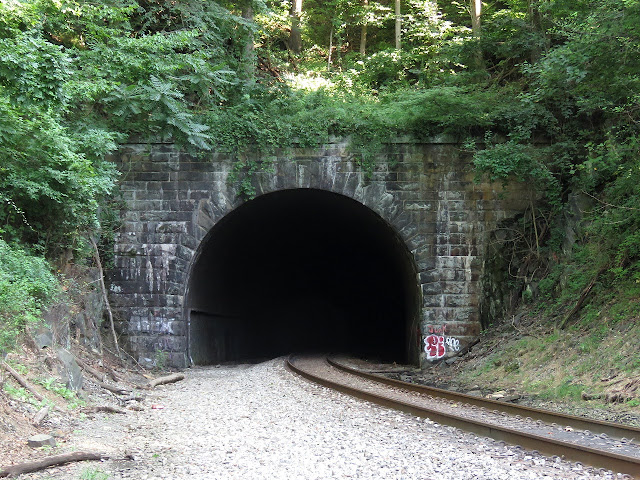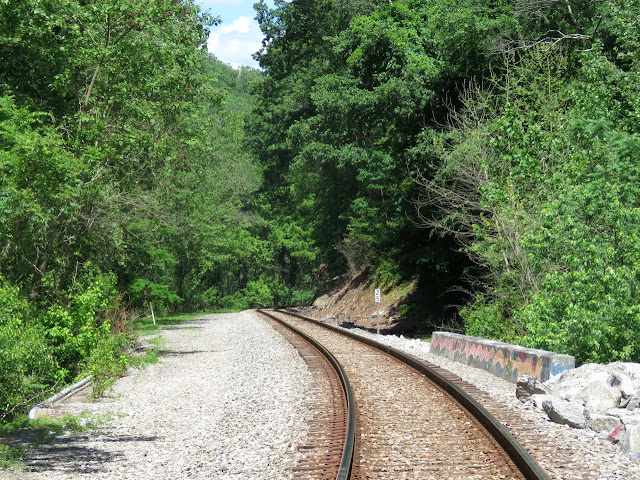The Baltimore and Ohio railroad's Old Main Line was the first railroads constructed in the United States and also one of the first in the world with the initial segment opening for service in 1830. Located in the narrow Patapsco River valley, the impetus for the line was the fact that Baltimore had an excellent sea port, but no means to transport goods inland as the city was not located at the end of a major waterway or canal. To remedy this the B&O would act as an artificial river, first transporting goods to the C&O Canal on the Potomac River with the eventual goal of reaching all the way to the Ohio River.
The intense profit motive of making Baltimore a national port not only justified the employment of cutting edge technology, but also the use of a sub-optimal rail route in the form of the twisty, turny Patapsco River valley. Although it was an early center of manufacturing due to its hydro power resources, the rail line soon became outmoded due to numerous tight curves. By the turn of the 20th Century, the B&O was engaged in a long term effort to re-align the curves and, where necessary, build the bridges and tunnels that were not feasible in the early decades of operation. The route would eventually include 9 tunnels, a large number for an East Coast rail line (for comparison that's about as many as the entire Reading system). During 2020 I was looking for some outdoor activities so I went about visiting several of the Old Main Line tunnels, most of which were about a mile or two from the nearest Patapsco River State Park carpark. The entire river valley has been converted into a recreation area with the railroad a popular right of way for people to reach their favorite spots on the river. You can find the full set of photos here ( mirror ).
Having already visited the Ilchester Tunnel in 2019, this year's tour will start with the Union Dam Tunnel located at milepost 15 (from Baltimore's Mt Claire terminal). Built in 1902 with stone portal fronts, the 810 foot long curved tunnel travels under the US 40 arch bridge that replaced the winding Old Frederick Road.
Next along the line at Milepost 19 is the 1022 foot long Dorset tunnel, constructed in 1906 with the same style of facing as the Union Dam tunnel. In addition to swimmers, the park is filled with forest puppies.
Standing between the Dorsey and Davis tunnels is one of the many plate girder crossings of the Patapsco river, necessary to smooth out some of the many curves. This would occasionally move the new right of way across the river from the 1830 alignment.
The Davis tunnel, at milepost 20, is only 497 feet long, but an internal curve prevents one from looking all the way through. It was completed in 1906 to support a double track main line that has since been reduced to single track leaving ample clearance and rendering the old side wall refuges, unnecessary. Somewhat unstable ground made full brick lining a must for all the OML tunnels.
Very little traffic was moving on the weekends, but I did happen to catch CSX SD40-2 #8064 with an MoW train at the Marriottsville Rd parking area. The MoW train contained both Conrail and Seaboard Coast Line equipment.
The 403 foot long Henryton tunnel located at Milepost 25 utilizes a more common B&O brick facing that could be found throughout its mountainous territory in West Virginia, southern Pennsylvania and southern Ohio. This tunnel was built in 1903.
The fully ballasted concrete bridge at milepost 25 was a departure from the typical plate girder setup.
The preserved B&O passenger station in downtown Skyesville, MD is currently a restaurant. The pandemic was allowing the owners time to conduct capitol improvements.
An Ex-Conrail / ex-SEPTA (#8102) caboose was sitting on the dump siding. Skyesville has a small transportation museum and this caboose is likely part of the collection.
This cinder block structure located past milepost 29 contained some old pumping equipment for what was once the local water supply. The pumps were manufactured by popular locomotive builder Fairbanks-Morse.
The Skyesville MoW siding stretches nearly a mile from town, earing just before the Skyesville bridge and tunnel complex.
At 240 feet the 1902 Sykesville tunnel is NOT the shortest OML tunnel, that distinction belongs to the Hartman tunnel at 215 feet, but it is the shortest tunnel I visited in this run.
The bridge-tunnel-bridge arrangement is common when railroads are cutting off horseshoe bends in rivers.
Well thanks for joining me on this little trek along the OML. I will leave the three remaining tunnels, Woodbine, Mt Airy and Hartman, for another time. If you would like to learn more about the OML check out the B&O photo tour website. I'll leave you with this video of MARC Camden Line train at Hamover Road in Elkridge with MP36PH-3C #35 leading with a sick horn.




























No comments:
Post a Comment